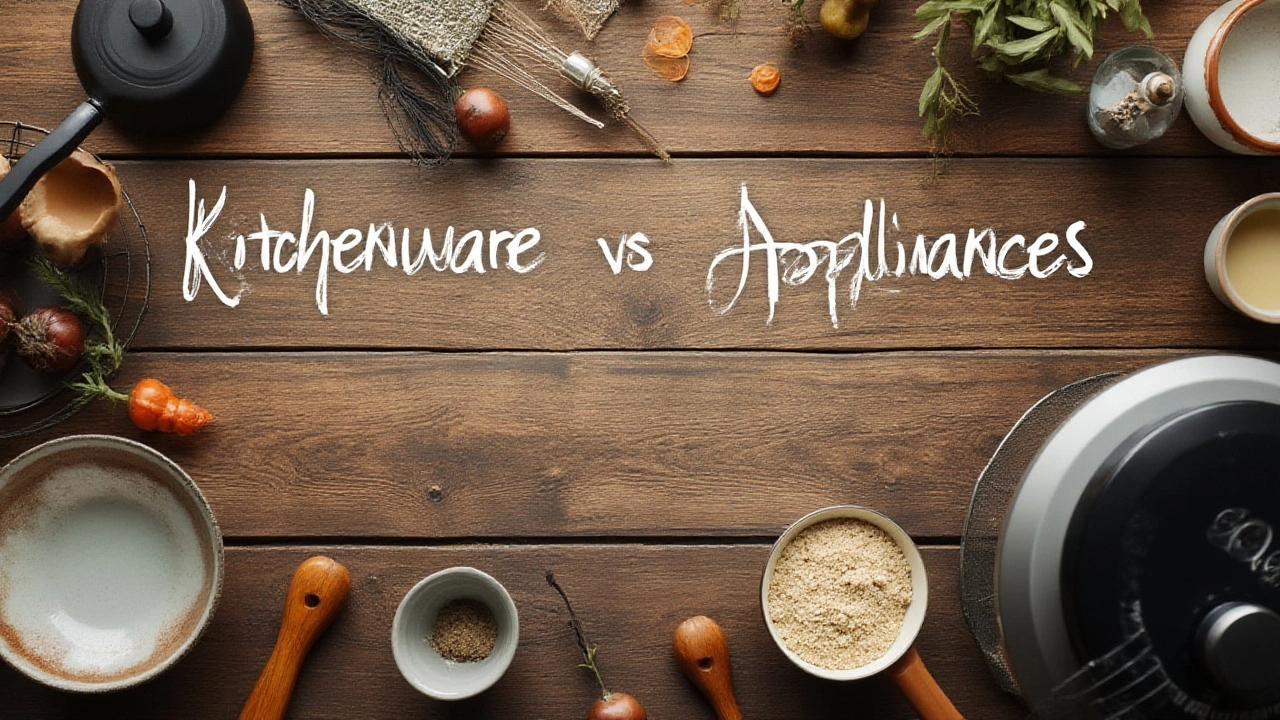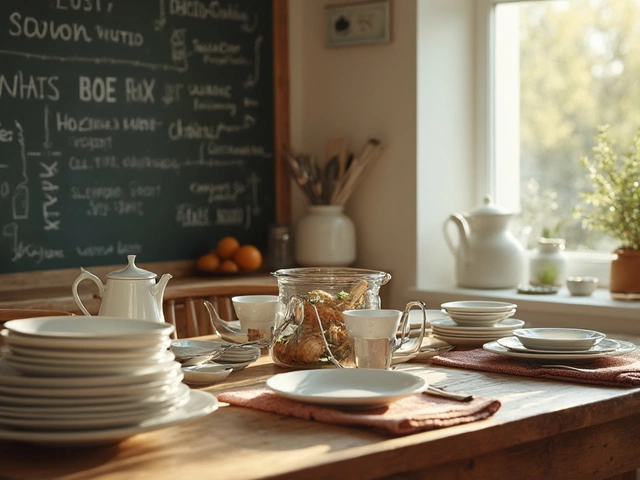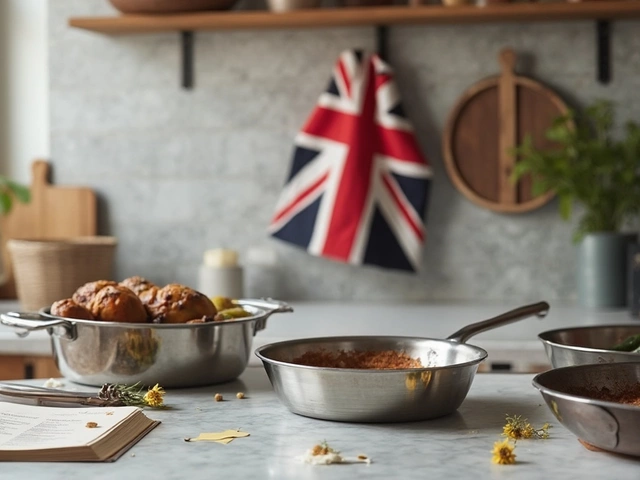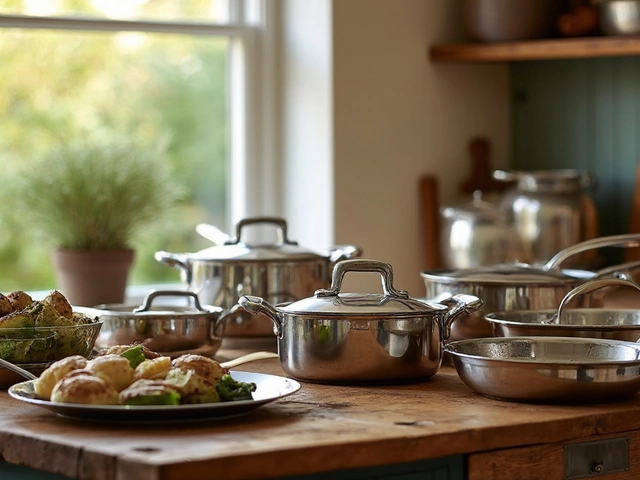Walk into any kitchen store in Auckland—or scroll through an online catalog—and the words "kitchenware" and "kitchen appliances" are plastered everywhere. But what actually divides these two? Is a coffee grinder kitchenware or an appliance? Do non-stick pans count as appliances just because they’re fancy? The lines can blur, and if you’re kitting out your own kitchen or just want to sound like you know what you’re doing at Briscoes, it’s downright annoying not knowing what’s what. Let’s clear it all up and give you the answers most store assistants never bother with.
The Difference Between Kitchenware and Kitchen Appliances
First, picture your kitchen. The bowls, spatulas, mixing spoons, and chopping boards you grab over and over—these are examples of kitchenware. Kitchenware covers all tools, utensils, dishes, and containers used to prepare, cook, serve, or store food. It’s the stuff you can usually pick up, move around, and clean without ever plugging in a cord. If it works without electricity, odds are it’s kitchenware.
Kitchen appliances, on the other hand, rely on some kind of power. No electricity, no action. These include things like fridges, microwave ovens, blenders, toasters, slow cookers, and even electric whisks. They’re machines, meaning parts inside are doing the work for you. If you’re flirting with the idea of a new kitchen gadget that needs to be plugged in or have batteries replaced, it’s definitely an appliance.
Got a fancy Japanese chef’s knife? Kitchenware. But an electric knife sharpener? That’s an appliance. Ceramic mixing bowls you inherited from your nan? Kitchenware. A stand mixer with a motor big enough to wake up the whole house? Appliance territory.
This division isn’t about size or price. A $5 spatula is kitchenware, but so is a $350 Le Creuset Dutch oven. A tiny electric milk frother the size of a marker is an appliance, even though you’ll spend less on it than you would for a chopping board.
Things can get muddier with kitchen gadgets that toe the line. Think manual coffee grinders: if you grind the beans by hand, it’s kitchenware; as soon as a motor steps in to do the cranking, it’s an appliance. The same goes for food processors—slicers with a spinning blade but powered by your muscles are still kitchenware, but plug them in and now you’re living in appliance land.
There are even hybrid tools, like stovetop espresso makers (kitchenware, since the heat comes from the hob) versus capsule-based electric coffee machines (appliance, no question). The moment heat production, grinding, or mixing happens electrically or mechanically, you’re in appliance territory. When hand power does the trick, it’s almost always kitchenware.
If you need a tiebreaker, ask yourself: if I took away all the electricity, would it still work the way it’s supposed to? If yes, it’s kitchenware. If not, you’re staring at an appliance. Still confused? Here’s a handy table to help you quickly sort some of the most common items you find in a modern kitchen, just like the ones tucked away in homes from Auckland to Whangarei:
| Item | Kitchenware | Kitchen Appliance |
|---|---|---|
| Chef's Knife | ✓ | |
| Blender | ✓ | |
| Cutting Board | ✓ | |
| Toaster | ✓ | |
| Manual Egg Beater | ✓ | |
| Electric Whisk | ✓ | |
| Mixer Bowl | ✓ | |
| Rice Cooker | ✓ | |
| Measuring Cups | ✓ | |
| Food Processor (manual) | ✓ | |
| Food Processor (electric) | ✓ |
Kiwis love their electric kettles: according to research from Canstar Blue, over 95% of New Zealand homes have one. That’s definitely an appliance—even if it’s prettier than half the décor in your kitchen. Wooden spoons, salad spinners (as long as you’re manually spinning), mortar and pestle? Still old-school kitchenware. If you ever end up playing charades and need to mime ‘kitchen appliance,’ just pretend to plug something in or push a button—no one will confuse you for a salad server.
One last curveball: built-in kitchen appliances like ovens and dishwashers are still appliances, even though they might seem like part of the walls. If it takes a technician to install or move it, you’re in appliance country. Same goes for those retro-style Smeg refrigerators taking over home magazines.

How Kitchenware and Kitchen Appliances Shape Everyday Cooking
Once you sort out what’s kitchenware and what’s an appliance, you start making much better decisions on what you actually need (and what you probably don’t). Fancy gadgets are tempting, but the truth is, a lot of world-class dishes come from simple kitchenware, not an army of motors and switches.
Think about basic Kiwi dishes: pavlova, roast lamb, fish and chips. None of these require some over-the-top gadget to whip up if you’ve got reliable kitchenware. A mixing bowl, good knives, and a sturdy roasting pan get you 90% there. Appliances make things easier or faster, sometimes both, but hardly ever replace the need for solid basics. A chef once said you only need three things to cook just about anything: a sharp knife, a strong pan, and a bit of patience. Everything else is gravy. If you accidentally burn that gravy with your slow cooker, at least you can blame it on the appliance.
There’s a reason global kitchen designers spend more time on utensil drawers and storage racks than on showcase appliances—they know home cooks reach for spoons and cups more than anything else. The average cook uses kitchenware ten times more often than small appliances, according to stats from Consumer NZ. Yes, even in tech-happy homes. Try making a salad in a food processor—you might get shredded leaves, but nothing beats the crunch you get from manual chopping.
That doesn’t mean appliances aren’t amazing. Anyone who’s ever made a smoothie with a quality blender knows the difference between creamy and chunky. Pressure cookers save hours on stews, slow cookers let busy families walk in to ready dinners, and the air fryer craze isn’t fading anytime soon (in fact, sales in New Zealand jumped over 23% last year—who knew we all loved crispy chips so much?). For buttering toast, a toaster is a lifesaver. But don’t believe the hype that you have to own every new gadget to be a good cook. One well-made skillet is more valuable than five niche appliances you never use.
There’s another key difference in terms of care and storage. Kitchenware is usually easier to clean (have you ever tried to scrub a blender’s blades without slicing off a finger?). Most kitchenware goes straight into the dishwasher, while appliances often need special cleaning or hand-wiping. Plus, when something in the appliance breaks, you can’t just fix it with a screwdriver. Broken kitchenware? Often a quick glue-up or replacement part does the trick. Appliance warranties can run out, and then you’re stuck with a glorified paperweight until payday rolls around. Be honest: how many times have you shoved a dead toaster to the back of the cupboard instead of fixing it?
Price doesn’t always tell you what’s essential. You might splurge on a food processor, but forget your knife skills and you’ll be slow in any kitchen. On the flip side, spending a little more for a good chef’s knife saves years of frustration. When in doubt, start by building your kitchenware arsenal. Later, add appliances that actually fit your lifestyle. If you love baking, a mixer might be worth more than an InstaPot. If your mornings are chaos, then that automatic coffee maker isn’t just a want—it’s survival.
Let’s be honest, though—sometimes it’s the fun new toy that keeps you excited about cooking. If throwing a batch of fries into the air fryer gets your teenagers to eat more at-home meals, that’s a win, even if you’re still using the wooden salad tongs from your first flat. The best cooks mix both: reliable, long-lasting kitchenware with a handful of trusted, hardworking appliances. If you find yourself using something more than once a week, it deserves a spot on the bench. The rest? Stash them or pass them along to someone who’s still charmed by novelty avocado slicers.

Shopping Tips: Picking the Right Kitchen Tools and Appliances for Your Home
Shopping for kitchen stuff can get overwhelming—even more so with all the deals popping up every five seconds. So how do you actually decide what’s worth buying, whether it’s old-fashioned kitchenware or shiny new appliances?
Start with a list of what you actually cook. If you rarely bake, you probably don’t need multiple cake tins or a stand mixer. Love hosting? Invest in sturdy serving dishes and at least one appliance like a blender or pressure cooker to help with bulk recipes. If you’re a minimalist, choose multi-purpose items: a cast-iron skillet works for frying, baking, and roasting, while an immersion blender can puree soups and whip cream without taking up as much space as a standing blender. The trick is to avoid buying the cute rice cooker unless you’re actually going to make rice more than once a month.
Here’s a helpful approach:
- Start with kitchenware basics: Think knives, chopping boards, mixing bowls, measuring cups and spoons, and heatproof utensils like spatulas and whisks.
- Add appliances for your most common meals: Coffee every morning? A reliable electric kettle or coffee machine is a must. Love smoothies or soups? Invest in a high-quality blender.
- Skip duplicate items: You probably don’t need both a hand mixer and a stand mixer. Pick one that matches your cooking style.
- Check appliance energy ratings: In New Zealand, look for the blue and yellow Energy Rating Label—a two-star jump can mean saving over $100 a year in power bills, especially for things like fridges and dishwashers. Not nearly as sexy as a new gadget, but your wallet (and the planet) will thank you.
- Go for quality where it matters: Invest a little extra in knives and pans—the stuff you grab daily. Appliances should actually solve a problem or make life easier, not just look good in social media posts.
- Don’t forget the warranty on appliances: According to Consumer NZ, the average small kitchen appliance lasts around 6 years; major kitchenware like pots or knives often lasts two decades if cared for well.
A fun fact for the sustainability-minded: glass and ceramic kitchenware are way easier to recycle than most appliances. At the end of their life, stainless steel utensils can also be chucked into scrap metal drives (great for school fundraisers). Old fridges and electric appliances, though? They need e-waste disposal—don’t just leave them at the curb hoping for the best, as Auckland City Council will issue fines for improper dumping. If you’re upgrading, many New Zealand retailers now offer take-back schemes for old appliances when you buy new ones. For those passionate about a cleaner planet, aim to buy gear that lasts longer and doesn’t need constant upgrades.
And if you’re gifting: kitchenware usually fits every home regardless of owner or kitchen type. Gifting appliances? Check compatibility—NZ electrical systems use 230V and type I plugs, so don’t order a US-made air fryer expecting it to work out of the box. (You’d be shocked how many people find that out too late.)
The biggest difference at the checkout: kitchenware purchases are usually smaller, so spreading out costs is easier. Appliances, by nature, pack a bigger financial punch. Shopping during Boxing Day or Black Friday sales in New Zealand? Keep a wishlist, but stick to what actually solves a real-life kitchen need. If you have to Google “what does an egg-poacher do,” maybe leave that on the shelf.
To wrap it up: kitchenware is everything you grab to mix, stir, cut, chop, serve, or bake—no plugs or cords needed. Kitchen appliances need power to run and are better for boosting your speed, batch size, or convenience. Get your basics sorted, then add appliances that will earn their place in your kitchen (and on your power bill). And the next time someone asks, “Is a rice cooker kitchenware or an appliance?” you’ll know exactly what to say.



